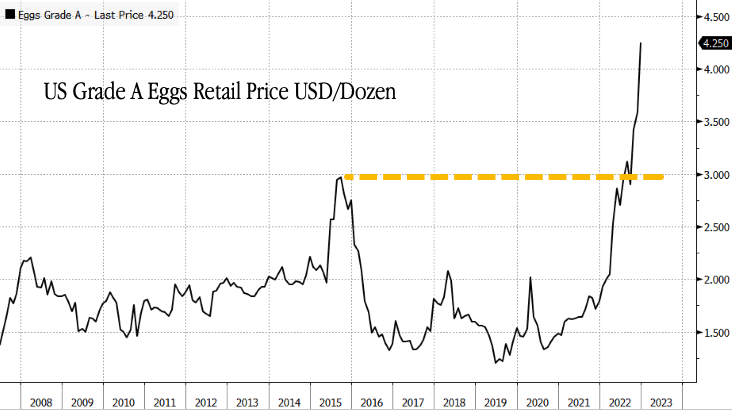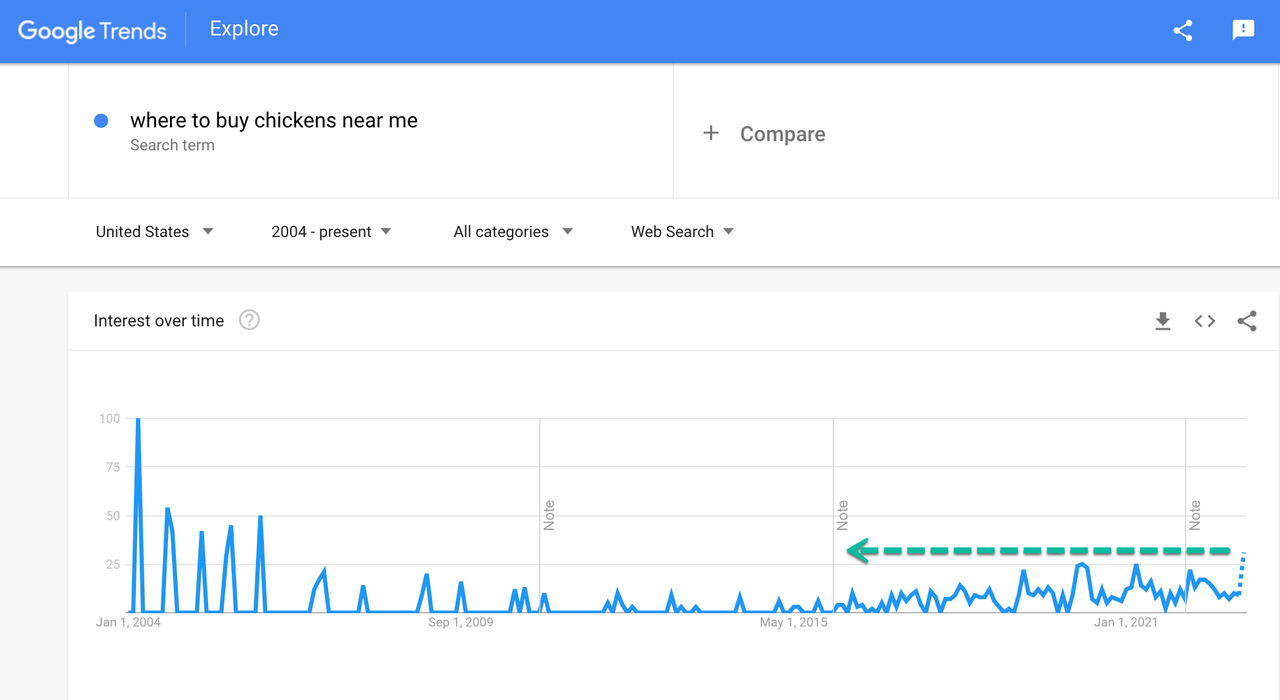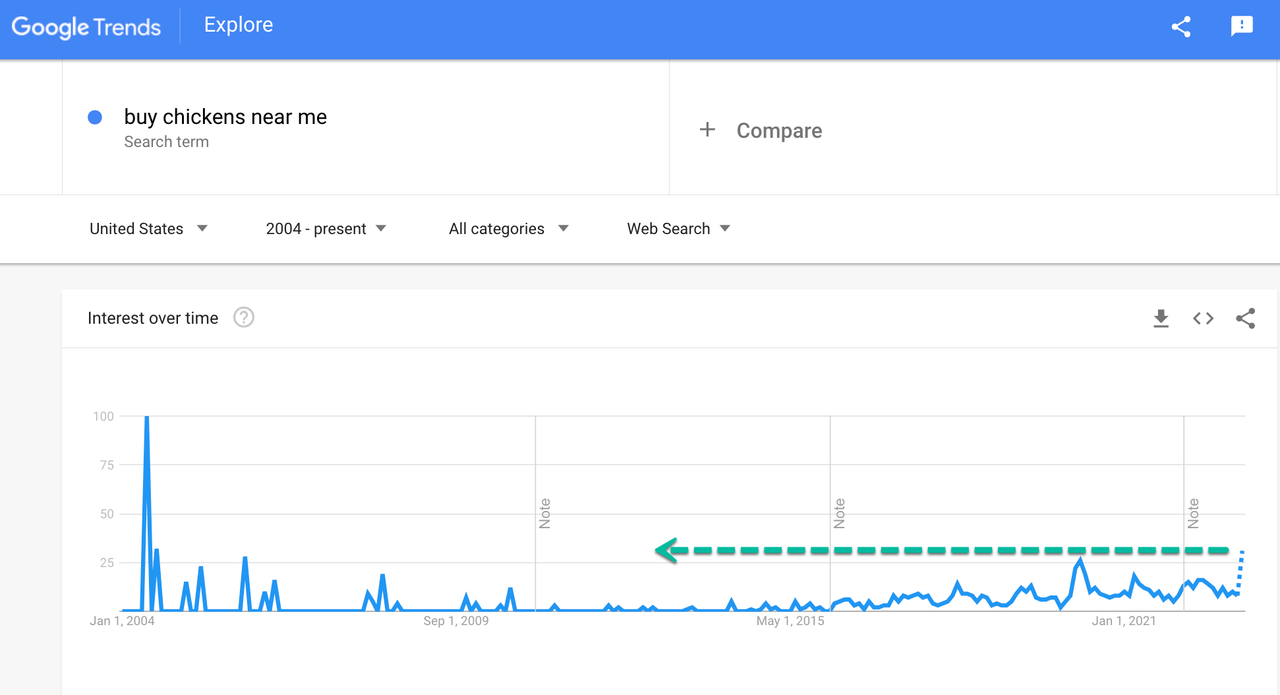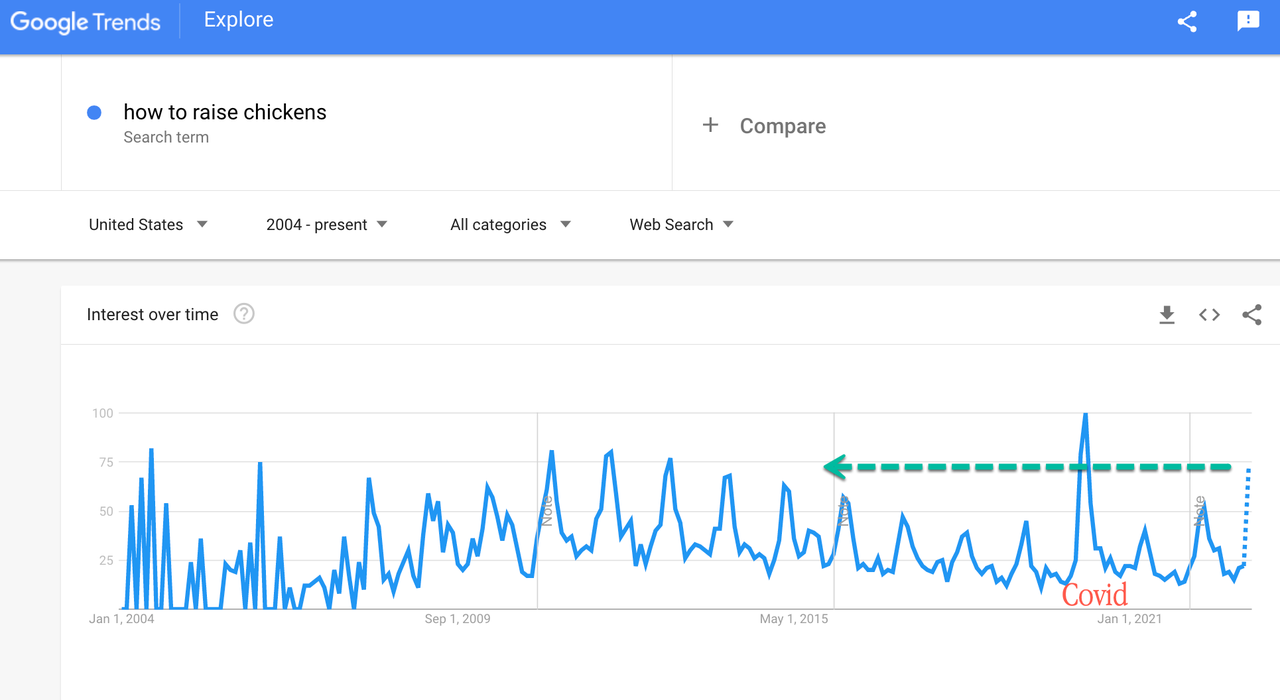Subscribe for free to the America First Report newsletter.
Yes.
That’s it. That’s the article. Well, it could be, because IF you have the means and IF you have the space and IF you’re physically capable of raising chickens, then you definitely should consider buying and raising them. I was saying this before eggs became so expensive in the United States that people started smuggling them from Mexican supermarkets. Now, it’s really a no-brainer. Here are three reasons why…
Better Taste
For a long time I didn’t really buy into the notion that fresh eggs were any better than store-bought eggs. Then, I tried some. My aunt raises chickens as does my wife’s sister. Both of us had separate opportunities to try actual “farm fresh” eggs that were laid within 24 hours of us eating them by chickens who were raised in backyards. Don’t let anyone tell you they are no different from grocery store eggs. It’s not even really a comparison. Then, there are the health benefits which I’ll leave for you to research, but I’ve heard farm fresh eggs are simply more nutritious.
Cheaper in the Long Term
Chickens are actually pretty cheap to buy. Building or buying a chicken coop can cost anywhere from a couple hundred dollars up to however much you want to spend on them. The feed and other regular expenses are rising, though they’re not terribly expensive just yet. Compare that to the price of eggs and suddenly it’s clear how around one egg per chicken per day can add up in the long-term to tremendous savings.
Indefinite Supply of Protein
Let’s call it what how we see it. The powers-that-be are in the process of eliminating and eventually outlawing natural forms of protein that aren’t insects. They want us eventually eating lab-grown meats or cricketburgers as our primary source of protein, and by “eventually” I hope everyone understands we’re talking about months or years, not decades.
Chickens properly raised and cared for can produce anywhere from three or four eggs per week to an egg per day each. That’s 5-8 grams of protein, not to mention other crucial nutrients, produced per chicken per day. Combine that with a freeze-dried protein bucket (promo code “prep2023” for 10% off or “prep2030” for 15% off orders over $777) and you’ll have a long-term supply of real protein from real animals instead of relying on the government’s mealworm lines.
If you’re thinking about buying and raising chickens, you’re not alone. According to the article below by Tyler Durden over at Zero Hedge, people are becoming more and more interested in the idea…
Egg Crisis Sparks Soaring Interest In Backyard Farms
Covid supply chain snarls turned millions of Americans into “preppers” overnight. The run on toilet paper, food, guns, ammunition, and other essential items for survival pushed millions to consider preparedness for a crisis.
Remember all those old-school preppers? The media used to refer to them as “extreme” and even called them “tin-foil hat conspiracy” folks, but during the shutdowns, those folks were right, and the mainstream media got it wrong.
The next shortage underway is eggs. Readers have seen our notes on supermarkets nationwide running out of eggs. The egg shortage is so severe that last week the US Customs and Border Protection reported that egg smuggling from Mexico erupted.
Important: Our sponsors at Jase are now offering emergency preparedness subscription medications on top of the long-term storage antibiotics they offer. Use promo code “Rucker10” at checkout!
And why is that? Well, a dozen Grade A eggs in the US have topped $4.25 at supermarkets. In Mexico, a 30 count of eggs is about $3.40.
US egg prices have topped the national average gasoline per gallon price at the pump.
As a result of the egg crisis, internet search trends on Google show Americans are panic searching where to find egg-laying hens for their backyard.
The search trend “where to buy chickens near me” erupted to a near multi-decade high.
“Buy chickens near me” searches explode across the US.
Besides the Covid spike, “how to raise chickens” has spiked to levels not seen in a decade.
Over the last several years, food insecurity has pushed many Americans to create ‘little backyard farms’- something their parents or grandparents did more than half a century ago. Living off the land was standard decades ago, but as metropolises sprung up, people relied more on a corporation (or even the government) to provide food.
Soaring distrust in government and corporations had transformed many into preppers following the pandemic shutdowns when some supplies were impossible to find. People don’t want to be left empty-handed when the next crisis arises. This has led to a new generation of preppers and the normalization of being prepared.
Speaking of Beef
Okay, so nobody brought up beef but I will. We are getting into the beef business, expanding our thriving freeze-dried chicken business to include cows. We only bought 10 cows for our initial run so it’s first come, first served. We have non-GMO cows that aren’t getting the dreaded mRNA vaccines the powers-that-be are pushing now. Grass fed, grain finished. We’ll be selling frozen steaks, ground beef, and roasts, PLUS we’ll be selling long-term storage freeze dried beef chunks. If you want to be notified when we open for orders, go to my beef page.
Alternative Video Sources:
Five Things New “Preppers” Forget When Getting Ready for Bad Times Ahead
The preparedness community is growing faster than it has in decades. Even during peak times such as Y2K, the economic downturn of 2008, and Covid, the vast majority of Americans made sure they had plenty of toilet paper but didn’t really stockpile anything else.
Things have changed. There’s a growing anxiety in this presidential election year that has prompted more Americans to get prepared for crazy events in the future. Some of it is being driven by fearmongers, but there are valid concerns with the economy, food supply, pharmaceuticals, the energy grid, and mass rioting that have pushed average Americans into “prepper” mode.
There are degrees of preparedness. One does not have to be a full-blown “doomsday prepper” living off-grid in a secure Montana bunker in order to be ahead of the curve. In many ways, preparedness isn’t about being able to perfectly handle every conceivable situation. It’s about being less dependent on government for as long as possible. Those who have proper “preps” will not be waiting for FEMA to distribute emergency supplies to the desperate masses.
Below are five things people new to preparedness (and sometimes even those with experience) often forget as they get ready. All five are common sense notions that do not rely on doomsday in order to be useful. It may be nice to own a tank during the apocalypse but there’s not much you can do with it until things get really crazy. The recommendations below can have places in the lives of average Americans whether doomsday comes or not.
Note: The information provided by this publication or any related communications is for informational purposes only and should not be considered as financial advice. We do not provide personalized investment, financial, or legal advice.
Secured Wealth
Whether in the bank or held in a retirement account, most Americans feel that their life’s savings is relatively secure. At least they did until the last couple of years when de-banking, geopolitical turmoil, and the threat of Central Bank Digital Currencies reared their ugly heads.
It behooves Americans to diversify their holdings. If there’s a triggering event or series of events that cripple the financial systems or devalue the U.S. Dollar, wealth can evaporate quickly. To hedge against potential turmoil, many Americans are looking in two directions: Crypto and physical precious metals.
There are huge advantages to cryptocurrencies, but there are also inherent risks because “virtual” money can become challenging to spend. Add in the push by central banks and governments to regulate or even replace cryptocurrencies with their own versions they control and the risks amplify. There’s nothing wrong with cryptocurrencies today but things can change rapidly.
As for physical precious metals, many Americans pay cash to keep plenty on hand in their safe. Rolling over or transferring retirement accounts into self-directed IRAs is also a popular option, but there are caveats. It can often take weeks or even months to get the gold and silver shipped if the owner chooses to close their account. This is why Genesis Gold Group stands out. Their relationship with the depositories allows for rapid closure and shipping, often in less than 10 days from the time the account holder makes their move. This can come in handy if things appear to be heading south.
Lots of Potable Water
One of the biggest shocks that hit new preppers is understanding how much potable water they need in order to survive. Experts claim one gallon of water per person per day is necessary. Even the most conservative estimates put it at over half-a-gallon. That means that for a family of four, they’ll need around 120 gallons of water to survive for a month if the taps turn off and the stores empty out.
Being near a fresh water source, whether it’s a river, lake, or well, is a best practice among experienced preppers. It’s necessary to have a water filter as well, even if the taps are still working. Many refuse to drink tap water even when there is no emergency. Berkey was our previous favorite but they’re under attack from regulators so the Alexapure systems are solid replacements.
For those in the city or away from fresh water sources, storage is the best option. This can be challenging because proper water storage containers take up a lot of room and are difficult to move if the need arises. For “bug in” situations, having a larger container that stores hundreds or even thousands of gallons is better than stacking 1-5 gallon containers. Unfortunately, they won’t be easily transportable and they can cost a lot to install.
Water is critical. If chaos erupts and water infrastructure is compromised, having a large backup supply can be lifesaving.
Pharmaceuticals and Medical Supplies
There are multiple threats specific to the medical supply chain. With Chinese and Indian imports accounting for over 90% of pharmaceutical ingredients in the United States, deteriorating relations could make it impossible to get the medicines and antibiotics many of us need.
Stocking up many prescription medications can be hard. Doctors generally do not like to prescribe large batches of drugs even if they are shelf-stable for extended periods of time. It is a best practice to ask your doctor if they can prescribe a larger amount. Today, some are sympathetic to concerns about pharmacies running out or becoming inaccessible. Tell them your concerns. It’s worth a shot. The worst they can do is say no.
If your doctor is unwilling to help you stock up on medicines, then Jase Medical is a good alternative. Through telehealth, they can prescribe daily meds or antibiotics that are shipped to your door. As proponents of medical freedom, they empathize with those who want to have enough medical supplies on hand in case things go wrong.
Energy Sources
The vast majority of Americans are locked into the grid. This has proven to be a massive liability when the grid goes down. Unfortunately, there are no inexpensive remedies.
Those living off-grid had to either spend a lot of money or effort (or both) to get their alternative energy sources like solar set up. For those who do not want to go so far, it’s still a best practice to have backup power sources. Diesel generators and portable solar panels are the two most popular, and while they’re not inexpensive they are not out of reach of most Americans who are concerned about being without power for extended periods of time.
Natural gas is another necessity for many, but that’s far more challenging to replace. Having alternatives for heating and cooking that can be powered if gas and electric grids go down is important. Have a backup for items that require power such as manual can openers. If you’re stuck eating canned foods for a while and all you have is an electric opener, you’ll have problems.
Don’t Forget the Protein
When most think about “prepping,” they think about their food supply. More Americans are turning to gardening and homesteading as ways to produce their own food. Others are working with local farmers and ranchers to purchase directly from the sources. This is a good idea whether doomsday comes or not, but it’s particularly important if the food supply chain is broken.
Most grocery stores have about one to two weeks worth of food, as do most American households. Grocers rely heavily on truckers to receive their ongoing shipments. In a crisis, the current process can fail. It behooves Americans for multiple reasons to localize their food purchases as much as possible.
Long-term storage is another popular option. Canned foods, MREs, and freeze dried meals are selling out quickly even as prices rise. But one component that is conspicuously absent in shelf-stable food is high-quality protein. Most survival food companies offer low quality “protein buckets” or cans of meat, but they are often barely edible.
Prepper All-Naturals offers premium cuts of steak that have been cooked sous vide and freeze dried to give them a 25-year shelf life. They offer Ribeye, NY Strip, and Tenderloin among others.
Having buckets of beans and rice is a good start, but keeping a solid supply of high-quality protein isn’t just healthier. It can help a family maintain normalcy through crises.
Prepare Without Fear
With all the challenges we face as Americans today, it can be emotionally draining. Citizens are scared and there’s nothing irrational about their concerns. Being prepared and making lifestyle changes to secure necessities can go a long way toward overcoming the fears that plague us. We should hope and pray for the best but prepare for the worst. And if the worst does come, then knowing we did what we could to be ready for it will help us face those challenges with confidence.










